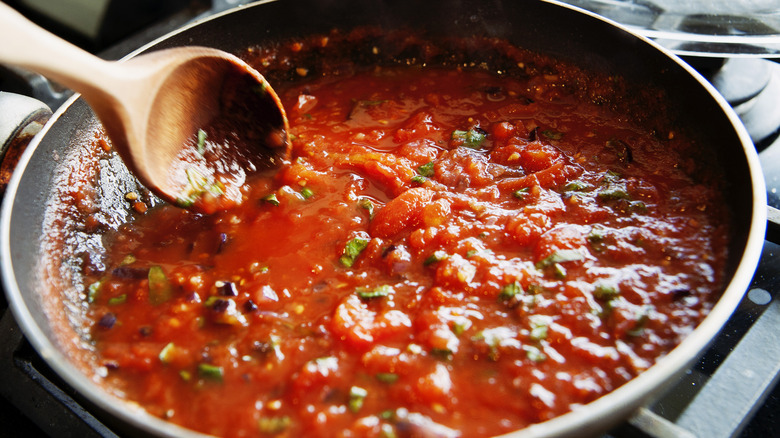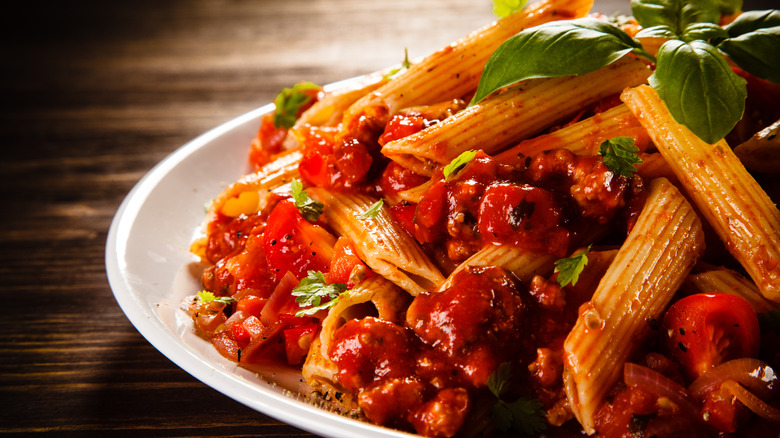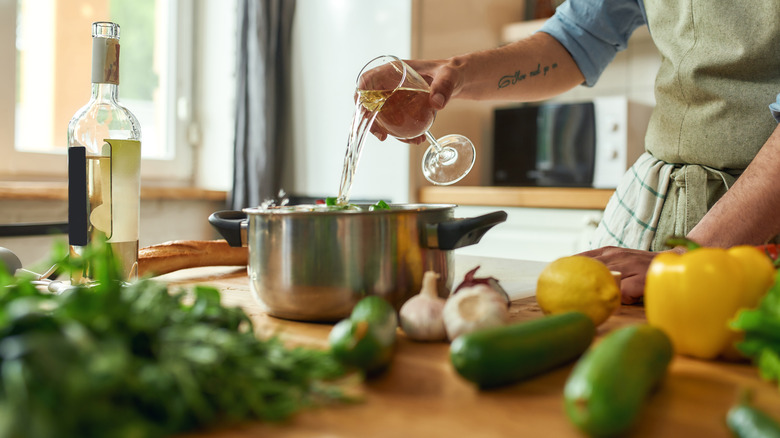What Is Sunday Gravy And What Is It Made Of?
When hearing the word gravy, many people think of the often gelatinous, meat-based sauce that accompanies meatloaf or turkey dinners. This type of gravy is typically derived from the essential juices of the meat being cooked and gets its thickness from cornstarch or flour. Like other food origin stories, it's not entirely clear when gravy became a Thanksgiving tradition. However, it's believed that it first appeared during the inaugural Thanksgiving feast in 1621 as a means of extending the meal on subsequent days by taking leftover meat and boiling it down into a broth.
While turkey gravy is undeniably delicious, and arguably the best part of a Thanksgiving feast, it's not the only sauce in town. According to people with Italian heritage, there's another form of gravy that is a constant accompaniment to Sunday meals. And while this recipe also includes meat, it features a tomato base that hews much closer to pasta sauce than the gravy associated with turkey preparations.
A tasty, generations-spanning culinary tradition
In Italy, where the tradition of Sunday gravy first originated, sauce is referred to as ragu. This term is actually taken from the French word ragout, which roughly means 'to rouse the appetite.' In addition to the tomato base, Sunday gravy is seasoned with herbs and simmered with different types of meat, such as meatballs and sausage. However, families typically add their own special touches to the recipe to make it unique. For example, some recipes include only pork or only beef, while others feature both types of meat to achieve the optimum flavor. On Facebook, celebrity chef Tom Colicchio advocates for including braciole, an Italian meat roulade usually made from flank steak, pork, or veal and stuffed with a cheese-herb-breadcrumb mixture.
As a culinary tradition, Sunday ragu is closely tied to the religious faith of many Italian families. It's commonplace to begin sauce preparations prior to attending church on Sundays, with the whole family gathering back at home to share in a meal after mass has ended. In this sense, Sunday gravy goes beyond a mere recipe and is more akin to a family tradition that upholds community and fellowship. Accordingly, home chefs are quite serious about how to create the perfect sauce to accompany pasta and other delicious foods.
Tips for making Sunday gravy your own
Both red and white wine make fine additions to tomato sauce. In general, white wine adds brightness and acidity to the dish, while red wine infuses the sauce with some depth of flavor and roundness. However, you want to add the wine soon after you begin cooking to ensure the alcohol reduces while the tasty flavors remain as the sauce thickens. Speaking of textures, many cooks swear by adding butter to their sauce, which is perfect for achieving the right level of smoothness.
When it comes to tomatoes, giving them a quick roast is another great way to enhance the flavor of the dish. This trick works well with fresh tomatoes as well as canned varieties. And while it may seem like an out-of-left-field choice, adding anchovies to the sauce while it's cooking elevates the flavor without imparting any worrisome fishiness. In addition to adding actual anchovy filets, you can also use a smattering of anchovy paste to ensure it meshes perfectly with the rest of the ingredients. The best Sunday gravy preparations make use of simple, wholesome ingredients capable of imparting big flavors, which is key for an amazing family feast.


